A fire alarm system is a safety system designed to warn people and allow them to leave a place in case of a fire. The system consists of various devices, including smoke, heat, hazardous gas sensors, etc. that detect changes caused by a fire. When the sensors indicate a fire, the system automatically activates sirens (bells, audible and visual devices) to alert people in the area.
In addition to sirens, the fire alarm system also notifies a control center so that rescue and firefighting teams can be quickly dispatched to the scene of the fire.
These systems are usually used in public places such as buildings, offices, shopping malls, hospitals and industries to ensure the safety and health of people. Fire Alarm System are of great importance and to prevent life and property damage caused by fire, it is essential to quickly and efficiently inform people of the environment in which they are located.

Fire alarm systems come in a variety of forms and come in different types depending on the needs of the specific environment in which they are installed. Below are some examples of the types of fire alarm systems:
These systems use smoke sensors to detect smoke produced by a fire. When smoke is detected, alarms are activated, alerting people to the potential danger. In other words, these systems detect changes in smoke concentration and activate alarms if smoke is detected. These types of systems are very effective at detecting fires that produce smoke but are not actually burning.
Choosing the right type of smoke fire alarm system depends on the needs of the environment in which it is used and must comply with the safety standards applicable to each region.
In this type of system, thermal sensors are used to detect temperature changes. If the temperature reaches a set maximum, the system activates the alarm. Heat Detection Systems use thermal sensors to detect temperature changes and increase in heat in places to detect fire.
These systems are mainly used to detect fires that do not produce smoke, such as low-smoke fires or in locations where the installation of smoke alarm systems is incomplete or impossible due to environmental conditions.
The selection of the appropriate type of heat alarm system depends on the requirements of the environment in which it is used and the timeliness of fire detection. Also, in many locations, a combination of smoke and heat alarm systems may be used to increase accuracy and efficiency.
These systems are used to detect and warn of fires involving hazardous gases, such as flammable or toxic gases. Gas sensors are sensitive to changes in the concentration of gases. Gas Detection Systems are used to detect and warn of fires involving hazardous or toxic gases in various locations.
These systems use gas sensors to detect levels of hazardous gases such as flammable gases, toxic gases, and complex toxic gases such as corrosive gases, above the maximum permissible levels.
Therefore, the selection of the appropriate type of gas fire alarm system depends on the type of hazardous gases present in the environment and must comply with the safety standards relevant to each region. These systems can be used in chemical, petrochemical, energy, factories and other places where there is a risk of explosion or release of hazardous gases.
These systems use CCTV cameras to detect a fire visually. They analyze changes in the image and provide an alert if a fire is detected. Video Fire Detection Systems use CCTV cameras and image recognition technology to detect and warn of fires.
These systems continuously monitor an image of the environment and sound an alarm if any signs of fire are detected. Video fire alarm systems can be used as an additional layer of security in places where smoke or heat cannot be detected quickly.
Video fire alarm systems are used in places that need to protect valuable objects or large areas, such as warehouses, shopping malls, factories and large commercial centers. They are used as an important and powerful tool to reduce the risk of fire and increase the safety of the working and living environment.
These systems have a larger number of sensors, and each sensor has a unique address. This allows for more accurate fire location detection.
Addressable Fire Alarm Systems (AFA) use advanced, newly developed AI systems to detect and report fires in various locations. These systems send critical and accurate information, as well as location, from any point on their network to a control center. Simply put, each device or sensor in these systems has a unique address, and fire detection information is accurately transmitted by these addresses.
The main features and elements of addressable fire alarm systems are as follows:
Addressable Sensors: Each sensor or device in this system has a unique address, which identifies it to the fire alarm control center. These addresses help to accurately distinguish locations and devices.
Accurate fire detection: Due to precise addressing, these systems have the ability to determine the exact location of the fire and the type of fire. This allows control centers to be quickly dispatched to the scene of the fire.
Remote monitoring: These systems utilize wireless communications and Wi-Fi networks for remote communication and embedded monitoring. This allows operators to view and control fire alarm systems remotely.
Ability to determine the exact location of the fire: By having precise information about the location and type of fire, addressable fire alarm systems allow rescue teams to be quickly dispatched to the exact location of the fire.
Reduction of false positives: Due to accurate addressability information, these systems reduce false positives and unnecessary warnings.
Accurate reporting: These systems are capable of storing and providing accurate information about fires and environmental changes that help responsible individuals or fire departments.
Addressable fire alarm systems are known for their advanced features such as accuracy, precise information, and precise fire location, and are usually installed in locations with high security needs and large environments.
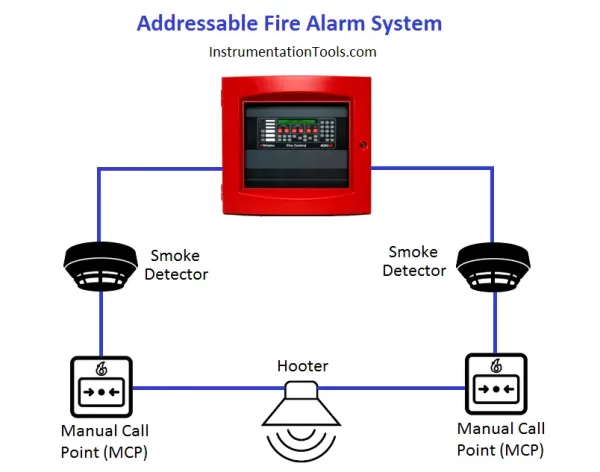
These systems are suitable for locations where wiring is difficult to install. They use wireless technology to transmit information to the control center.
Wireless Fire Alarm Systems use wireless technology to detect and report fires in various locations. These systems operate without the need for hardware cabling and are easy to install and repair. Applications Wireless fire alarm systems are usually used in places where installing hardware cables is difficult or where there is a need for greater flexibility in system changes and network expansion. These types of systems use wireless technology to communicate devices and report fires to a control center or rescue teams.
A combination of different types of sensors and equipment may be used to increase the accuracy and efficiency of fire alarm systems. The selection of the appropriate system type depends on the type of location, environmental hazards, and security needs.
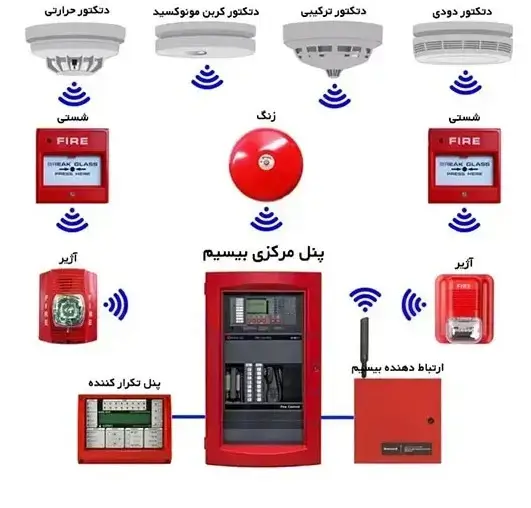
A conventional fire alarm system is a safety system used to detect and report fires in various locations, including buildings, commercial, industrial, and community centers. This system includes a wide range of devices and equipment to notify people of potential hazards and initiate firefighting measures in the event of a fire. The most important components of a conventional fire alarm system are as follows:
A conventional fire alarm system is one of the most fundamental safety elements in various locations and is essential for maintaining the safety of people and environments. A combination of sensors, fire alarm devices, and control equipment allows this system to quickly detect fire incidents and take appropriate security measures.
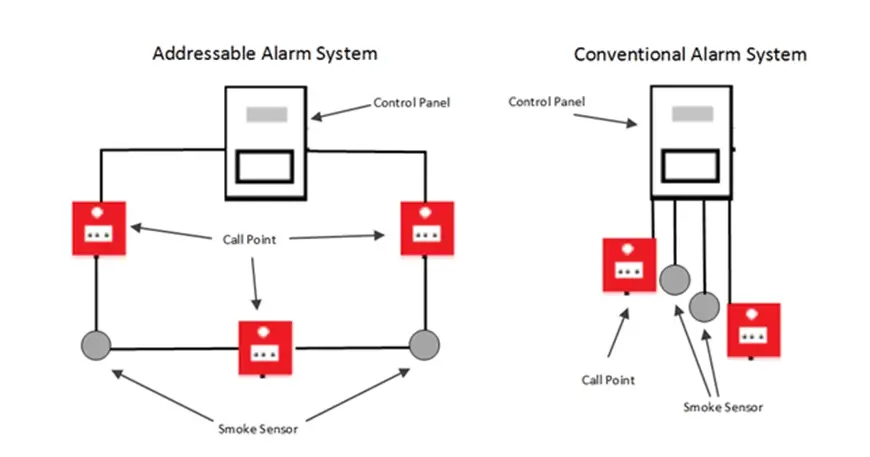
The following buildings and structures are required to implement fire alarm systems, according to the rules and regulations of fire alarm systems in topics 1 and 31 of the National Building Regulations and the internationally recognized standards NFPA72, EN54, and BS5839, which include:
Single-unit commercial buildings with an area of 500 square meters or more, including commercial buildings built next to each other and not having a common entrance.
Commercial buildings with a common entrance with a total area of 300 square meters or more.
Commercial-office buildings and office-residential buildings with more than three floors above ground or an area of 300 square meters or more
Commercial and residential buildings with a total of 5 units and more
In buildings with mixed uses, if each use requires a separate fire detection and alarm system according to the descriptions in the above paragraphs or the residential tables, a fire detection and alarm system must be installed in the entire building.
In mixed-use buildings where a fire detection and alarm system is required, the above system must be selected, designed, and implemented as an integrated or related system.
Fire Alarm System Diagram Reading is an important skill for technicians and those responsible for installing, repairing, and maintaining these systems. This skill allows them to interpret system-related drawings and diagrams and correctly implement them in different locations. The following is an explanation of fire alarm system diagram reading:
Identifying the main elements: The first step in reading a fire alarm system diagram is to identify the main elements of the diagram. These elements typically include smoke detectors, fire detectors, control panels, sound adjustment devices (silencers), manual call points, and wiring.
Understanding Wiring: Fire alarm system diagrams show how the various components of the system communicate with each other. This includes connecting wires, cables, and describing the wiring routes on the diagram.
Interpreting Signal Diagrams: These systems have displays that indicate various problems and conditions through audible and visual signals. The diagram should provide an explanation of these displays and how they work.
Designation of fire-sensitive locations: The map should show specific locations as fire-sensitive locations. This usually includes the locations where smoke detectors and fire alarms are installed.
Compliance with standards: Drawings must comply with national and local safety standards. This includes things like the type of sensors, number of manual call points, and wiring restrictions.
System Installation and Setup: After interpreting the drawings, technicians must install and setup the system according to the drawing instructions.
Reading fire alarm system blueprints is of great importance because it allows those responsible for implementing the system to install and adjust these systems accurately and in accordance with standards, ensuring their correct and safe implementation.
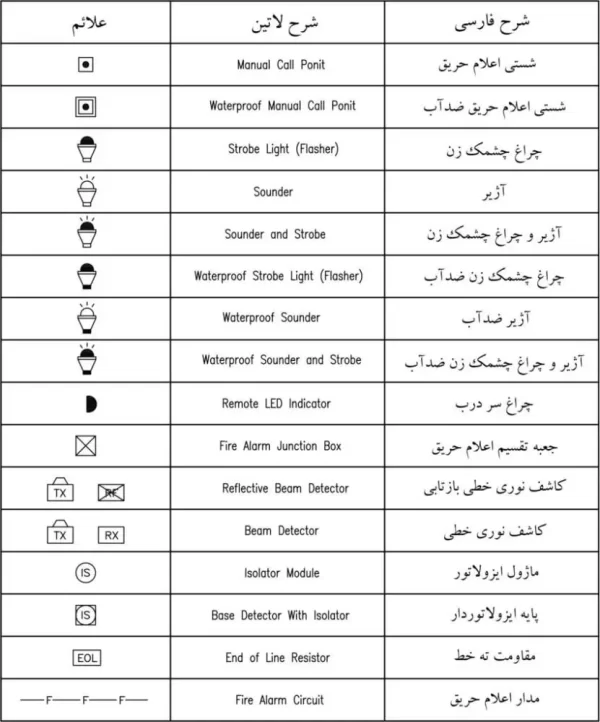
In fire alarm systems, the concepts of Loop and Zone are two important terms that relate to different zones or devices in a fire alarm system. These two terms have different meanings and applications:
1-Loop:
A loop is defined as a specific physical path or wiring in a fire alarm system.
Fire alarm devices connected together with cables and connectors are placed in a loop.
Each ring has two terminals, a start and an end, and devices are connected sequentially along the ring.
Loops are commonly used in wired fire alarm systems.
In the event of a fire or failure in one part of the loop, the devices in that part will not be able to send a fire signal.
2_ Zone:
A zone is defined as a specific area or region in a fire alarm system. Fire detectors and sensors are logically divided into zones.
Zones are commonly used in Wireless Fire Alarm Systems or Addressable Fire Alarm Systems.
Each zone has different features and can be set and controlled independently. In the event of a fire or fault in one zone, only that zone will trigger a fire alarm and the other zones will not be affected.
The main difference between a loop and a zone in fire alarm systems is that a loop is considered a physical path along which devices and sensors are connected, while a zone is defined as a logical area in which devices and sensors are logically assigned. Both concepts are very important for managing and determining the exact location of a fire in fire alarm systems and are used depending on the type of system.
Types of fire alarm systems include conventional fire alarm systems, addressable fire alarm systems, and wireless fire alarm systems.
A fire alarm system must meet at least one of the international standards such as the American NFPA standard, the American UL&FM standard, the European EN54 standard, or the British BS58 standard.
Conventional and addressable fire alarm systems differ in terms of wiring, installation, location, and price. The wiring in a conventional fire alarm system is two-wire, but in an addressable fire alarm system, it is circular. Also, the purchase price of a conventional fire alarm system is lower and its installation price is higher than that of an addressable fire alarm system.
The important thing about fire alarm systems is their periodic maintenance, which is often not done or not done properly. With one, two, or three false alarms, and more, the employer or project owner ultimately prefers to turn off the system.
Each of the above, in its own right, has a significant impact on reducing the false alarm rate in fire alarm systems. And to have an efficient and effective fire alarm system, all of the above points and items must be considered in the implementation of such projects.
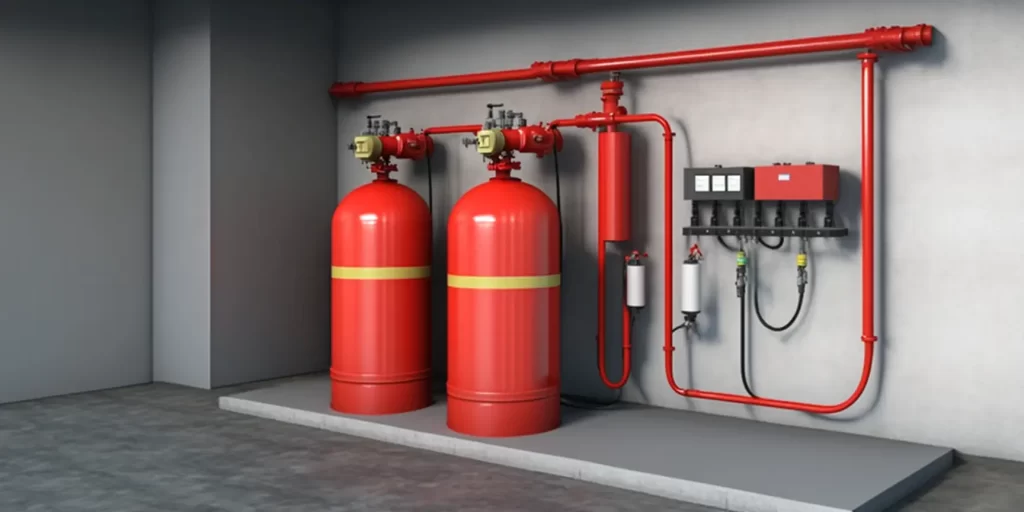

Imen Datis Asia Company, relying on up-to-date knowledge, continuous activity and cooperation with highly specialized forces, is now recognized as one of the leading private sector companies in the field of safety and firefighting industry. This company is always trying to continuously and dynamically play a role in expanding the safety and firefighting infrastructure of our beloved country of Iran and take great steps towards achieving goals such as the development and industrialization of new technologies.
Imen Datis Asia company, with expertise in supplying and equipping fire alarm and extinguishing systems, is a leader in providing quality products and specialized consultations. With an experienced team, we are trying to provide the highest level of security and protection to our customers.
All material and intellectual rights of this site are reserved for Imen Datis Asia